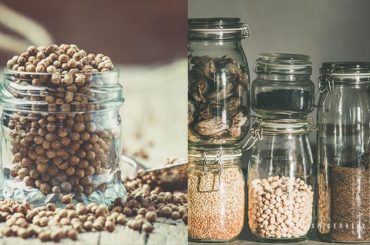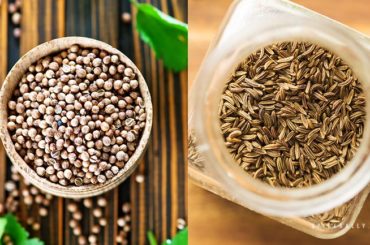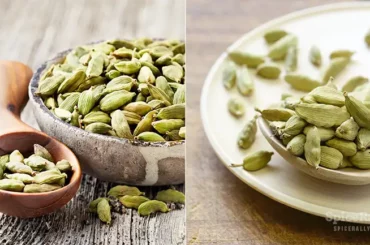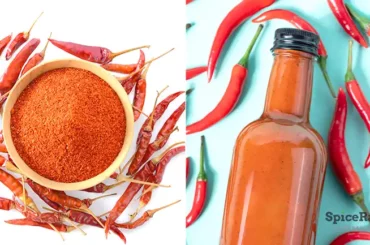If you are a loyal customer at the Asian grocery store, you might have often come across these easily confused rhizomes. So, if you ever want to try them both, you need to know how they differ. Here’s a complete guide to ginger vs galangal.
Galangal is typically more intense, bolder, and piney, with less sweetness but slightly bitter undertones. But ginger is more sweet, fresh, warmly spicy, and is left with a mild pepperiness when eaten raw. They also differ in texture and appearance when closely observed.
We know you have lots of questions about choosing and using these two culinary spices. So, keep reading for answers!
Ginger vs Galangal
| Ginger | Galangal | |
|---|---|---|
| Flavor profile | Has a milder, sweeter, fresher taste than galangal. And it has warmly spicy and peppery undertones. | Is bolder, sharper, and more intense than ginger. Has a piney, menthol-like taste with spicy, peppery, and slightly bitter notes. |
| The aroma profile | Has a more peppery smell than galangal with a warm, citrus-like, gentle fragrance. | Has a strong piney fragrance with menthol-like hints. |
| Forms | – As fresh rhizomes – Dried rhizomes – Ground – Pickled – Preserved – Paste – Powdered – Granulated – Pills/ capsules – As teas – As an essential oil | – Fresh rhizomes – Dried rhizomes – Powdered – As galangal root extract capsules – As galangal root extract essential oil |
| Availability | Readily available in grocery stores, supermarkets, Asian grocery stores, and online shopping sites. | Can be bought effortlessly through online sellers, Asian grocery stores, and could be found in supermarkets. |
| Purpose in cooking | As an ingredient and a condiment | As an ingredient and a condiment |
| Usage in cooking | – Fresh ginger is integrated into broths, soups, stews, and stir-fries. – Ground/powdered ginger is used in many spice blends and seasoning mixtures. – Pickled ginger is enjoyed as a condiment in Asian cuisine. – Works as a major flavoring in many marinades and wet rubs. – Ginger-garlic paste is often used as the base for many Asian curries. – Preserved ginger is incorporated into cakes and puddings. – Sri Lankans commonly enjoy fresh ginger by infusing it with black tea. – Can be incorporated into juices and smoothies. | – Mainly used in Thai curry pastes, soups, stews, broths, and stir-fries. – Is used to make Asian-inspired satay. – Can be used to make certain beverages. – Used with many coconut-milk-based curries. – Can be mixed into salads and salad dressings. – Fresh galangal is often used in noodle dishes. – Used to make many meat and seafood dishes. – Occasionally incorporated into certain desserts and sweets. |
| General use | – Used in baking and cooking – As a traditional Ayurvedic medicine and incorporated into home remedies – Used to make certain medicines in modern pharmacology | – Used in cooking and baking – As a traditional Ayurvedic medicine and incorporated into home remedies – Used to make certain medicines in modern pharmacology |
| Health benefits | – Helps to relieve morning sickness and nausea – Aids in treating chronic indigestion – Might support in lowering bad cholesterol levels – Contains anti-cancer properties – Have potential benefits with obesity and promote weight loss. – Alleviates the symptoms of osteoarthritis – Has anti-diabetic properties – Significantly decreases menstrual pain – Enhances brain function – Improves heart disease factors | – Is rich in antioxidants – Contains anti-carcinogenic properties – Might boost male fertility – Reduces inflammation and pain in the body – May fight against infections – Strengthens immune system – Contains anti-microbial properties – Improves skin health – Helps with digestive issues – Might have properties that would boost brain health |
| Main featuring cuisines | – Indian – Western – Korean – Thai – Vietnamese – Chinese – Japanese | – Thai – Indonesian – Chinese – Malaysian – Cambodian – Vietnamese – Laos – Singaporean |
| Appearance | A fleshy, plump root with grayish-light brown peel and pale yellow flesh. | It looks quite similar to ginger, but it is usually harder than ginger and has a woody texture, darker brown exterior, and fleshy interior. |
| Scientific name | Zingiber officinale | Alpinia galanga |
| Plant family | Zingiberaceae | Zingiberaceae |
| Active compounds | – Gingerol – Shogaols – Paradols | – Cineol – Fenchyl acetate – Farnesene – Bisabolene – Bergamotene – Pinene – Acetoxychavicol acetate |
| Origin | Southeast Asia | Southeast Asia |
| Storage | – Fresh, unpeeled ginger can stay well in the refrigerator for about a month when stored properly. – When stored in a tight-fitting glass container, ground/powdered ginger will stay fresh for about 3-4 years. | – Fresh galangal will stay fresh for up to one week when refrigerated. – Fresh rhizomes can also be kept in the freezer in resealable plastic bags for up to a month. – Powdered galangal can be stored in well-fitting glass containers with the rest of the spices. |
More About The Difference Between Ginger And Galangal…
Even though the looks of these two spices can be more likely deceiving, as we explained through the table above, you see that they are pretty much different. Ginger and galangal belong to the same extended plant family but have distinctive properties, flavors, usages, etc.
In fact, ginger is considered a versatile, ubiquitous spice that comes in many forms and is widely available in many parts of the world. But galangal, on the other hand, is prominent in Thai cuisine and can be seen mostly in Southeast Asian cooking.

Moreover, although some use galangal for certain desserts and beverages, ginger features in a majority of sweets, baked goods, desserts, and beverages. This is mainly because its mild yet pungent flavor profile has the capability to pair well with other ingredients. Nevertheless, ginger is used to substitute galangal and vice versa in some recipes like curries, soups, and stir-fries.
And, in terms of health benefits, it is very hard to give victory to one spice since both are rich in nutrients. However, due to the easy accessibility and availability of ginger, it seems that people are getting more benefits through this spice than from galangal.




